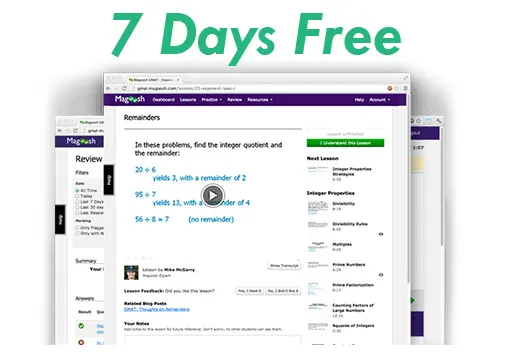A gas station contaminates petrol with kerosene to earn extra profit, which costs
one-third of petrol and contributes only 20% to mileage. The mileage of a motorist
dropped from 20 to 16 after filling up his tank which was almost empty. If the gas
station initially earned 12.5% profit on pure petrol sale, what is the additional profit
percentage being earned due to contamination?
(A) 7.5% (B) 10% (C) 5% (D) 17.5% (E) 22.5%
Percentage
This topic has expert replies
-
Harshita567
- Newbie | Next Rank: 10 Posts
- Posts: 1
- Joined: Tue Jul 30, 2019 10:46 pm
-
terminator12
- Junior | Next Rank: 30 Posts
- Posts: 13
- Joined: Tue Jul 28, 2020 9:01 pm
Good question!
Initially, the mileage was 20. That means pure petrol gives mileage of 20
So, kerosene gives mileage of 4
Let the % of petrol filled by the motorist be x, and % of kerosene filled be (1-x)
20*x + 4*(1-x) = 16
We get x = 75%
Old cost to the gas station (C) = 100%*p
New cost to the gas station (C') = 75%*p + 25%*\(\frac{p}{3}\) = \(\frac{5p}{6}\)
Earlier, \(\frac{S}{C}\) = 1.125
Now, \(\frac{S}{C'}\) = \(\frac{6}{5}\) * 1.125 = 1.35
Hence, the additional profits are 35% - 12.5% = 22.5%
Answer should be E.
Initially, the mileage was 20. That means pure petrol gives mileage of 20
So, kerosene gives mileage of 4
Let the % of petrol filled by the motorist be x, and % of kerosene filled be (1-x)
20*x + 4*(1-x) = 16
We get x = 75%
Old cost to the gas station (C) = 100%*p
New cost to the gas station (C') = 75%*p + 25%*\(\frac{p}{3}\) = \(\frac{5p}{6}\)
Earlier, \(\frac{S}{C}\) = 1.125
Now, \(\frac{S}{C'}\) = \(\frac{6}{5}\) * 1.125 = 1.35
Hence, the additional profits are 35% - 12.5% = 22.5%
Answer should be E.
The mileage of a motorist dropped from 20 to 16 after filling up his tank which was almost empty.
From this, we know that milage with only petrol = 20
And milage with petrol + kerosene = 16
But, given that kerosene contributes only 20% to mileage.
Hence, milage with Petrol = 20
and milage with kerosene = 0.2 (20) = 4
Therefore, the ratio in which petrol and kerosene are mixed in the new fuel is: P:K = 12:4 = 3:1
i.e. 75% P and 25% K
Consider the pump were selling non-diluted Petrol. Then,
100 amt of petrol would be sold for 112.5
Now we have diluted petrol where 75% is petrol and 25% is kerosene. And kerosene costs
one-third of petrol.
So, the 100 amt is actually 75 + (25/3) = 250/3 amt
So 250/3 amt is being sold for 112.5
Thus profit percentage= [ {112.5-(250/3)} / (250/3) ] * 100 => 35%
Hence, the additional profit% = 35% - 12.5% = 22.5%
Answer E
Thanks,
Ignite
From this, we know that milage with only petrol = 20
And milage with petrol + kerosene = 16
But, given that kerosene contributes only 20% to mileage.
Hence, milage with Petrol = 20
and milage with kerosene = 0.2 (20) = 4
Therefore, the ratio in which petrol and kerosene are mixed in the new fuel is: P:K = 12:4 = 3:1
i.e. 75% P and 25% K
Consider the pump were selling non-diluted Petrol. Then,
100 amt of petrol would be sold for 112.5
Now we have diluted petrol where 75% is petrol and 25% is kerosene. And kerosene costs
one-third of petrol.
So, the 100 amt is actually 75 + (25/3) = 250/3 amt
So 250/3 amt is being sold for 112.5
Thus profit percentage= [ {112.5-(250/3)} / (250/3) ] * 100 => 35%
Hence, the additional profit% = 35% - 12.5% = 22.5%
Answer E
Thanks,
Ignite



















